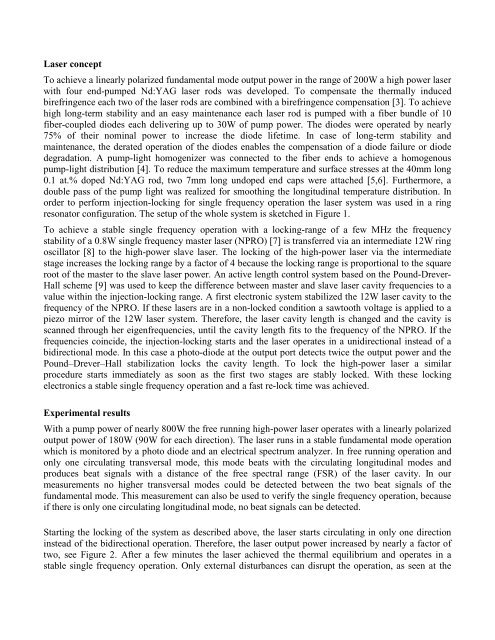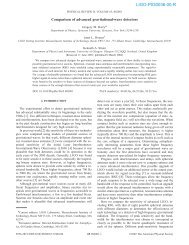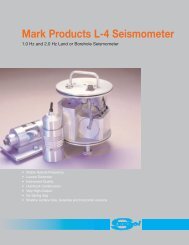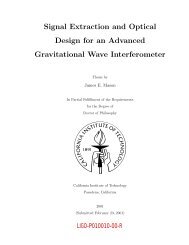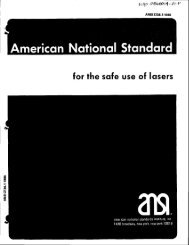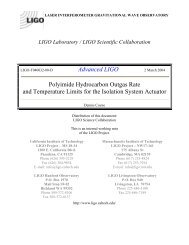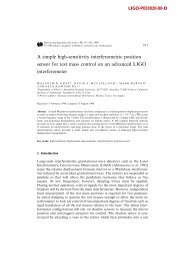High-Power Fundamental Mode Single-Frequency Laser - LIGO
High-Power Fundamental Mode Single-Frequency Laser - LIGO
High-Power Fundamental Mode Single-Frequency Laser - LIGO
You also want an ePaper? Increase the reach of your titles
YUMPU automatically turns print PDFs into web optimized ePapers that Google loves.
<strong>Laser</strong> concept<br />
To achieve a linearly polarized fundamental mode output power in the range of 200W a high power laser<br />
with four end-pumped Nd:YAG laser rods was developed. To compensate the thermally induced<br />
birefringence each two of the laser rods are combined with a birefringence compensation [3]. To achieve<br />
high long-term stability and an easy maintenance each laser rod is pumped with a fiber bundle of 10<br />
fiber-coupled diodes each delivering up to 30W of pump power. The diodes were operated by nearly<br />
75% of their nominal power to increase the diode lifetime. In case of long-term stability and<br />
maintenance, the derated operation of the diodes enables the compensation of a diode failure or diode<br />
degradation. A pump-light homogenizer was connected to the fiber ends to achieve a homogenous<br />
pump-light distribution [4]. To reduce the maximum temperature and surface stresses at the 40mm long<br />
0.1 at.% doped Nd:YAG rod, two 7mm long undoped end caps were attached [5,6]. Furthermore, a<br />
double pass of the pump light was realized for smoothing the longitudinal temperature distribution. In<br />
order to perform injection-locking for single frequency operation the laser system was used in a ring<br />
resonator configuration. The setup of the whole system is sketched in Figure 1.<br />
To achieve a stable single frequency operation with a locking-range of a few MHz the frequency<br />
stability of a 0.8W single frequency master laser (NPRO) [7] is transferred via an intermediate 12W ring<br />
oscillator [8] to the high-power slave laser. The locking of the high-power laser via the intermediate<br />
stage increases the locking range by a factor of 4 because the locking range is proportional to the square<br />
root of the master to the slave laser power. An active length control system based on the Pound-Drever-<br />
Hall scheme [9] was used to keep the difference between master and slave laser cavity frequencies to a<br />
value within the injection-locking range. A first electronic system stabilized the 12W laser cavity to the<br />
frequency of the NPRO. If these lasers are in a non-locked condition a sawtooth voltage is applied to a<br />
piezo mirror of the 12W laser system. Therefore, the laser cavity length is changed and the cavity is<br />
scanned through her eigenfrequencies, until the cavity length fits to the frequency of the NPRO. If the<br />
frequencies coincide, the injection-locking starts and the laser operates in a unidirectional instead of a<br />
bidirectional mode. In this case a photo-diode at the output port detects twice the output power and the<br />
Pound–Drever–Hall stabilization locks the cavity length. To lock the high-power laser a similar<br />
procedure starts immediately as soon as the first two stages are stably locked. With these locking<br />
electronics a stable single frequency operation and a fast re-lock time was achieved.<br />
Experimental results<br />
With a pump power of nearly 800W the free running high-power laser operates with a linearly polarized<br />
output power of 180W (90W for each direction). The laser runs in a stable fundamental mode operation<br />
which is monitored by a photo diode and an electrical spectrum analyzer. In free running operation and<br />
only one circulating transversal mode, this mode beats with the circulating longitudinal modes and<br />
produces beat signals with a distance of the free spectral range (FSR) of the laser cavity. In our<br />
measurements no higher transversal modes could be detected between the two beat signals of the<br />
fundamental mode. This measurement can also be used to verify the single frequency operation, because<br />
if there is only one circulating longitudinal mode, no beat signals can be detected.<br />
Starting the locking of the system as described above, the laser starts circulating in only one direction<br />
instead of the bidirectional operation. Therefore, the laser output power increased by nearly a factor of<br />
two, see Figure 2. After a few minutes the laser achieved the thermal equilibrium and operates in a<br />
stable single frequency operation. Only external disturbances can disrupt the operation, as seen at the


